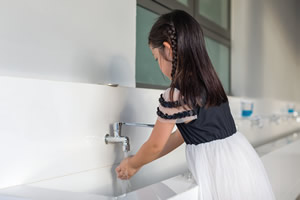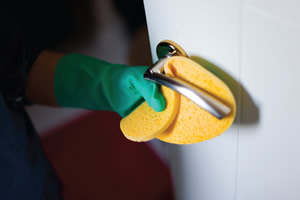Five Ways to Kickstart Your School's Cleanliness

PHOTO © SUPPARSORN
Fall is here, and that means the return
of cold and flu season. It’s also the perfect time to make
sure your cleaning program makes the grade when it comes
to preventing the spread of these common illnesses and other
infectious diseases.
Cleanliness is often measured by visual standards, evaluating
the visible levels of dirt and grime instead of measuring
by quantitative criteria. Unfortunately, this approach can have
a detrimental effect on health and wellbeing, in addition to
becoming increasingly costly. With the proper implementation
of a high-performance cleaning and maintenance program, the
social and economic costs of a less-than-clean school can be
significantly reduced.
What are the real costs?
On average, students in the United States miss 38 million
school days per year because of the flu. While a concerning statistic
on its own, consider the fact that chronically absent students
are 7.4 times more likely to drop out of school. A student’s ability
to learn can also be affected by a dirty environment. The presence of contaminants, such as dust and allergens, can impact cognitive
skills, including typing, arithmetic, logical reasoning, memory
and creative thinking, by two to six percent.

PHOTO © HENRIK JONSSON
When students get sick, it increases the likelihood that teachers
and staff will also become ill. Every year, teacher absences cost
the United States $25 billion. This comes before the additional $4
million expense of hiring substitute teachers as replacements. Allowing
for school environments to remain dirty quickly becomes
a comparable expense to investing in protocols that would reduce
these negative effects.
What can you do?
It’s a reality that kids will get sick from time to time, but the
implementation of an effective cleaning regimen can decrease
the likelihood of students and staff catching the flu by up to 80
percent. These five steps can help your school prevent the spread of
germs and other pathogens.
1. Educate about germs. Understanding the basic facts behind
germs, viruses and other environmental pathogens is one of the
first steps for establishing effective cleaning measures. Educate
teachers and staff with basic but fundamental information that
will increase their awareness and appreciation of the critical role
of cleaning in protecting our health:
- Touching a contaminated surface and then touching your
eyes, nose or mouth is one of the most common ways germs
are transmitted.
- Cold and flu viruses can live on surfaces up to 48 hours.
- Some bacteria can live on surfaces for months, increasing the
amount of people that become sick as well as the duration of
their illness.
2. Evaluate your campus. What are the common surfaces
with the highest levels of contamination? This list will likely
include stair rails, door handles, water fountains and sink
surrounds — any surface with a “high touch” point, meaning
those touched most frequently by the highest number of
people. Cleaning and disinfecting these surfaces regularly and
thoroughly significantly reduces the number of environmental
pathogens present on any given surface.
3. Pick your products wisely. It’s important to make sure the disinfectant
products your facility management team uses are appropriate
for fighting the types of germs in your school’s environment.
Identify products tailored to combatting cold and flu germs.
4. Clean and disinfect correctly. Always follow label directions
on cleaning products and disinfectants. It’s important to note
that the directions on most disinfectant products require the
surface to first be cleaned. Clean surfaces with a general purpose
cleaner to remove germs, and then use an EPA-registered
disinfectant to kill germs.
5. Promote hand hygiene. Keeping hands clean is one of the most
important steps we can take to avoid getting sick and spreading
germs, such as the influenza or cold virus, to others. Hand
washing with soap and clean running water is the most effective
way of removing germs from the hands. However, hand sanitizers
are also effective if soap and water are unavailable.

PHOTO © QUINN MARTINSUPPARSORN
It’s common knowledge that school budgets are being cut. As a
result, overall cleanliness is suffering. Currently, only 43.5 percent
of school districts provide guidance for infectious disease prevention,
as cleanliness is usually defined by visual inspection only.
In order to combat this issue and reduce the negative impacts on
your school, implement the steps outlined above to create a healthy
environment for your students, teachers and staff.
For more information on how to improve school cleanliness,
download the ISSA Clean Standard: K-12, a free tool your school
can use to measure and improve cleaning effectiveness, at www.issa.com.
About the Author
Bill Balek is the director of Legislative and Environmental Services at ISSA where he oversees the association’s legislative, regulatory and environmental programs. He has over 30 years of experience in the cleaning industry. Balek is an attorney licensed to practice in Illinois, and holds an MBA in marketing from DePaul University Kellstadt Graduate School of Business. For more tips and information, visit issa.com/infectionprevention.